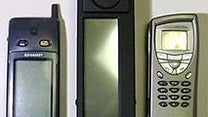Did you know what was the first smartphone ever?

Smartphones are on their way to becoming ubiquitous – everyone seems to have one already. What's more, there are no signs indicating that their popularity is to decline anytime soon. It wasn't always like this, of course. In fact, the term "smartphone" didn't even exist until the late '90s. That was a time when smartphones could only do a small fraction of the things that their modern counterparts are capable of. Still, as primitive (by today's standards) as they were, they paved the way for a number of influential, game-changing mobile devices to follow. Curious to learn more about the very first smartphones? Alright, then let's rewind back to a few decades ago and see how it all began.
Extending the humble phone's functionality beyond the scope of making calls is an age-old idea. Take for example this concept for a device that could serve as both a landline phone and a digital assistant. Designed with a touchscreen interface, it was very advanced for its time, and judging by the images, its uses included things like writing checks and storing contact information. This smartphone of sorts was conceptualized in 1983 by a German company called frog design. Its customer was Apple Computers, as you can surely tell by the old-school logo. Alas, this smartphone of sorts was never released commercially, but its existence, albeit at a conceptual level, goes show that even 30 years ago, people saw potential in a device combining phone and PDA functionalities. It would take another 9 years for a cellphone fitting this description to materialize. And it wasn't made by Apple.
This is the IBM Simon Personal Communicator, often referred to as the first smartphone ever. A prototype of it was introduced in 1992, but it wasn't until two years later when BellSouth Cellular released the handset in the U.S. for $899 on a 2-year contract or $1099 without commitment.
The first "smartphone" concepts
Extending the humble phone's functionality beyond the scope of making calls is an age-old idea. Take for example this concept for a device that could serve as both a landline phone and a digital assistant. Designed with a touchscreen interface, it was very advanced for its time, and judging by the images, its uses included things like writing checks and storing contact information. This smartphone of sorts was conceptualized in 1983 by a German company called frog design. Its customer was Apple Computers, as you can surely tell by the old-school logo. Alas, this smartphone of sorts was never released commercially, but its existence, albeit at a conceptual level, goes show that even 30 years ago, people saw potential in a device combining phone and PDA functionalities. It would take another 9 years for a cellphone fitting this description to materialize. And it wasn't made by Apple.
The IBM Simon
This is the IBM Simon Personal Communicator, often referred to as the first smartphone ever. A prototype of it was introduced in 1992, but it wasn't until two years later when BellSouth Cellular released the handset in the U.S. for $899 on a 2-year contract or $1099 without commitment.
In a nutshell, the IBM Simon was a cellphone with PDA features – something that business users must have been very excited about. The Simon offered utilities such as a calendar, a world clock, and an appointment scheduler, it could send and receive emails, it could exchange faxes over its 9600-bps modem, and it was even technically capable of running third-party applications stored on a memory card or on its 1MB of internal memory. That relatively huge screen in its front is a monochrome, backlit touchscreen with a resolution of 160 by 293 pixels. Using the handheld's stylus, one could draw sketches and input hand-written text, although our guess is that the accuracy of the latter feature was underwhelming.
Over 50,000 units were sold in the U.S. until February 1995, when the carrier discontinued the Simon.
The Ericsson R380
But while the IBM Simon was, technically, the first commercially available mobile device that could be called a smartphone, it wasn't referred to as such. The first smartphone ever marketed using the term "smartphone" was the Ericsson R380, which hit the market in 2000 at a price of about $700. It was also the first smartphone running the then-new Symbian operating system.
Unlike other smartphones at the time, the Ericsson R380 was about the size and weight of a typical cellphone. It weighed only 164 grams, while the Nokia 9210 Communicator, in comparison, was a 244-gram brick. Its form factor also made it an interesting device. The R380 featured a standard numeric keypad that revealed a spacious resistive touchscreen when flipped open.
Feature-wise, the Ericsson R380 came loaded with an arsenal of organizer functions, such as a calendar, a to-do list, a world clock, voice memos, and a contacts manager. It also featured an infra-red port for exchanging data and offered a built-in modem for accessing the internet via the phone's WAP browser. Exchanging emails back and forth was also in its feature set. However, as advanced as it was for its time, the R380 could not have additional apps installed on it.
And these, guys, were the first smartphones that the world saw. We've come a long way since then, haven't we? Drop us a line in the comments below if you agree.












Things that are NOT allowed: